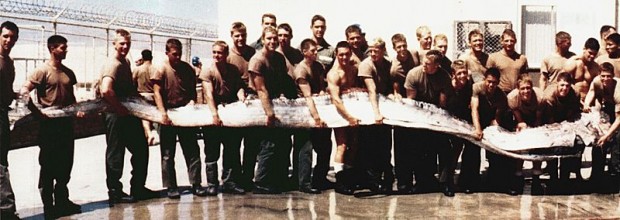Video: Rare Footage Of Elusive Ocean Oarfish
The rare capture of footage of a giant oarfish in California serves as a reminder of when an oarfish washed up in Bermuda 150 years ago; creating a frenzy as it was thought to be a “sea serpent”.
The oarfish observers were kayaking as part of a tour with the Shedd Aquarium in Baja, California and the video was posted online on Monday [Apr 7] and it has already garnered over a million views, having been picked up by numerous international media outlets.
The video was posted on YouTube by Shedd Aquarium, who wrote: “During a recent Shedd Adventures trip to Baja, participants witnessed not one, but two rare oarfish in shallow waters.”
Both oarfish in the video are around 15ft long – but others have been measured over three times that length. They are believed to have been behind many seafaring tales of mythical sea monsters.
Rare footage of oarfish posted by Shedd Aquarium
When the carcass of a 30-foot long oarfish washed up in Bermuda in 1860 newspapers and magazines around the world carried hair-raising stories on the “Bermuda sea monster.”
Reportedly found by George Trimingham, the deep-sea oarfish are rarely seen at the surface, and are the source of many legends about sea serpents.
According to the National Geographic the giant oarfish has been rarely seen because it lives at considerable depths. The elusive creatures, which are also known as ribbonfish, can reach up to 50 feet and weigh up to 600 pounds.
In 1860 Harper’s Magazine ran an depiction of the creature lying on the South Shore under the screaming headline “The Great Sea Serpent Found in Hungary Bay, Bermuda”.
The image was reproduced around the world, and even the sober-minded Scientific American was caught up in the fevered conjecturing, reporting that “the sea serpent has been caught at Bermuda in the form of a huge creature…”
Depiction of the “great sea serpent” found in Bermuda that was carried in the media
Headlined “The Sea Serpent Caught At Last,” another report mused what this “singular inhabitant of the briny world” should be called.
“What is the proper designation of this sea monster,” questioned the article. ” It has already been widely spoken of as the sea serpent or as an offspring of that seldom seen and much doubted denizen of the ocean.”
Citing its “long tapering form” and the “mode by which it probably propelled itself through the water” the report declared the creature was “not undeserving of being styled a member of the sea serpent family.”
A letter written to the NY Times said how fortunate it that a Matthew Jones — the author of The Naturalist in Bermuda – was visiting Bermuda at the time of the capture of the “sea serpent.”
U.S. servicemen holding a 23-foot oarfish which was found washed up in California in 1996
Dated February 21, 1860, it said: “It was most fortunate that the capture of the member of the sea serpent family took place while we had sojourning amongst us a practiced hand in natural science…”
But it was a case of mistaken identity. The creature which washed up in Bermuda is now thought to have been one of the reclusive oarfish.
Giant oarfish have occasionally been seen at the water’s surface, but scientists think they are pushed there by storms or strong currents, or they end up there when in distress or dying.
Read More About
Category: All, Environment, History, Videos




I would crap myself if that thing floated up next to me!
An oar fish….so….at one time a boatman utilised this fish as an oar…?